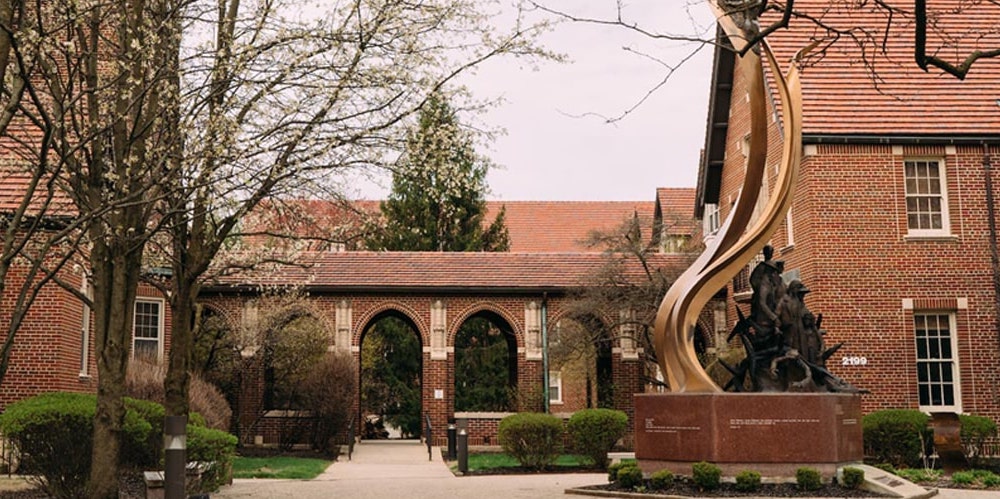About Trinity Lutheran Seminary

The Rev. Kathryn A. Kleinhans, Ph.D.
Dean
Trinity Lutheran Seminary at Capital University
A Welcome Message from Dean Kit Kleinhans
I BELIEVE THE HEART OF THEOLOGICAL EDUCATION IS FORMING FAITHFUL, WISE AND COURAGEOUS LEADERS TO WITNESS TO THE GOOD NEWS OF JESUS CHRIST IN WORD AND ACTION.
The church is called to be a servant-witness in the world. That requires leaders who are formed in faith, informed by knowledge, and experienced in practical application of their learning. As the world around us changes, church leaders need to be able to speak the Gospel in new ways to new audiences in new contexts.
Whether you are a prospective student discerning a call to ministry or to further theological study, an alumnus or alumna eager to see your alma mater continue preparing strong leaders for the church’s work in the world, or a friend interested in supporting this mission with your financial gifts, we are grateful to be in relationship with you. In the words of hymn writer Richard Leach, ‘Come, join the dance of Trinity!’
Quick Links
History
Trinity Lutheran Seminary at Capital University continues the heritage of nearly two centuries of theological education in Ohio. The seminary began its life in Canton in 1830, later moving the work of training pastors to Columbus. In March of 1850, at the request of the Joint Synod of Ohio, the seminary’s Board of Directors chartered an academy, Capital University. From 1850 to 1959, the Evangelical Lutheran Theological Seminary was part of Capital University.

Another Lutheran body in the region, the English Synod of Ohio, founded Wittenberg College at Springfield in 1845, also intended to train pastors for the church as well as members of other professions. The two church bodies represent the two halves of the church that formed after a schism in 1840. As the landscape of Lutheranism in Ohio evolved over the next century, these bodies would become the Lutheran Church in America (LCA) and the American Lutheran Church (ALC), respectively. By the early twentieth century, Wittenberg’s Hamma Divinity School and the Evangelical Lutheran Theological School shared an allegiance to the Lutheran Confessions, the Common Service used by several Lutheran bodies in North America, and much common history. They remained divided by their affiliations with these separate church bodies.
As early as the late 1950s, discussions began about the possibility of a combined seminary to serve Ohio and the surrounding region. By 1959, ELTS was no longer a part of the Capital University and operated under the direction of the ALC. During this time, both seminaries underwent changes, both evolutionary and revolutionary. In the 1960s and 70s, leaders of both church bodies worked together to define a vision of theological education. In 1974, work began in earnest to bring ELTS and Hamma together as one seminary, prior to a predicted merger of the ALC and LCA. On September 1, 1978, Trinity Lutheran Seminary opened to students from both schools, producing its first graduating class in May of 1979.

In 2016, Capital University and Trinity Lutheran Seminary decided that once again, it would best serve the students, the church, and the longevity of the seminary, for another change in structure to go forward. Trinity Lutheran Seminary at Capital University became a reality at the beginning of 2018, allowing students and faculty the advantages of being part of the university, and Capital access to the rich history and resources of the seminary. Today, Trinity operates within the university system, sharing resources from financial and registrar systems to library services, allowing undergraduate and graduate students the advantages of both a seminary and a larger university.
Students enjoy reminders of our history in the variety of architectures and memorials around campus. The stained glass hanging in the atrium and the stone cross in the breezeway both came from Hamma School of Theology. Additions that are more modern include the celebrated “Promise for Life” sculpture, installed and dedicated in 1999. “Promise for Life” is a memorial to the Holocaust by artist and Holocaust survivor Alfred Tibor, located in the courtyard of the old ELTS Divinity Hall.
Directions to the Seminary
Trinity is the proud home of Hamma Library, two beautiful chapels, large courtyards, the Promise of Life Holocaust Remembrance Sculpture, large conference spaces, and, of course, ample classrooms and offices.
Our address is 2199 E Main Street, which, if you put it in your GPS, will take you to the intersection of Main and College. To access our parking from Main and College, please turn on College toward campus. Our parking lot is the first lot on your right.
